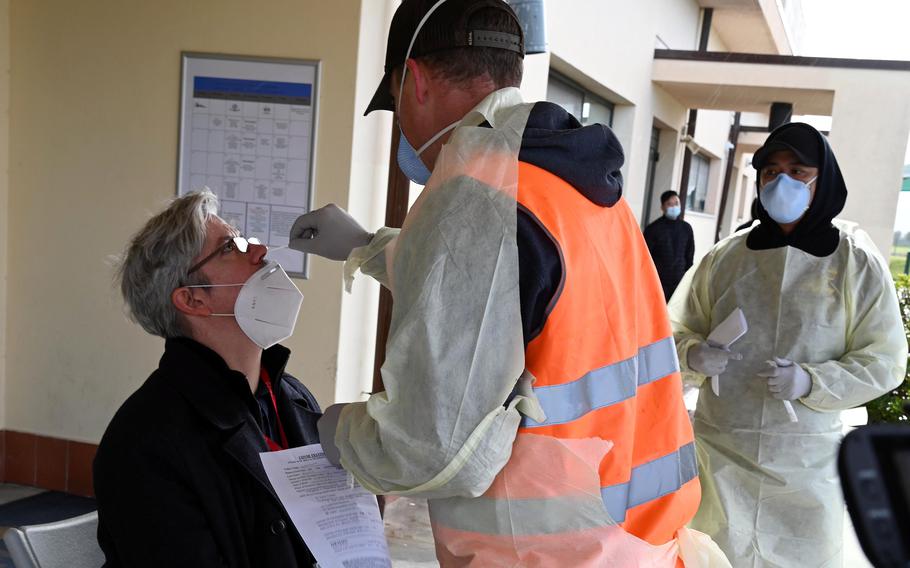
Matthew Arnold has a rapid antigen COVID-19 test taken at Naval Air Station Sigonella, Jan. 10, 2022. Four Italian regions, including the two that are home to Aviano Air Base and Naval Air Station Sigonella, moved into Italy’s second highest COVID-19 risk category Jan. 24, 2022, triggering new restrictions for the unvaccinated. (Kegan E. Kay/U.S. Navy)
Stars and Stripes is making stories on the coronavirus pandemic available free of charge. See more stories here. Sign up for our daily coronavirus newsletter here. Please support our journalism with a subscription.
NAPLES, Italy — Four Italian regions, including two that are home to Aviano Air Base and Naval Air Station Sigonella, moved into Italy’s second-highest COVID-19 risk category Monday, triggering new restrictions for the unvaccinated.
The classification means people who are not vaccinated won’t be able to travel outside of work or health reasons in most cases. They also won’t be able to go to shopping malls on weekends but could go during the rest of the week, Aviano said on its website.
People who have been vaccinated in the last nine months or received a booster shot aren’t subject to any further restrictions, the base said.
In Italy, unvaccinated people already are barred from most activities and many services, including at restaurants and going to the cinema, sporting events or museums. They can still go to the grocery store or pharmacy but can’t use public transportation.
The change would not result in additional restrictions for fully vaccinated personnel at Sigonella but the base “strongly” encourages vaccinations and continued mask usage, said Lt. Drake Greer, a NAS Sigonella spokesman.
Dr. Michael Parenteau, an NSA Naples lieutenant commander and region public health emergency officer, called the omicron variant a “tidal wave” that was starting to impact the on-base population, while speaking at an NSA Naples Facebook town hall meeting Thursday,.
However, the Navy in Naples, along with Sigonella, Naval Station Rota in Spain and Naval Support Activity Souda Bay in Greece would not release infection rates or other details, said Lt. Cmdr. Matthew Comer, a Navy Region Europe Africa Central spokesman.
“Some of our bases have seen an increase in cases and continue to follow COVID health protection, reporting, and notification protocol in order to protect our communities and maintain operational readiness,” Comer said in a statement.
Italy’s regions of Abruzzo, Piedmont, Friuli Venezia Giulia and Sicily were moved into the orange risk zone due to increased cases, hospitalizations and intensive care admissions, the Italian Health Ministry said Monday. Friuli Venezia Giulia and Sicily are home to Aviano and Sigonella, respectively.
Italy uses a color-coded system — red, orange, yellow and white — to classify COVID-19 risk and apply additional mitigation restrictions. NSA Naples and U.S. Army Garrison Italy in Vicenza remain in yellow risk zones.
The health ministry reported 138,860 new infections and 227 deaths on Sunday. There were about 1.18 million new infections and 2,440 deaths nationwide in the preceding week, the ministry said.